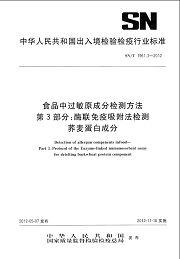天然产物 糖类和糖苷 Saccharides and Glycosides
Fagomine;(Synonyms: 荞麦碱; D-Fagomine) 纯度: ge;98.0%
Fagomine 是一种温和的糖苷酶 (glycosidase) 抑制剂,Fagomine 作用于 Amyloglucosidase (A.niger),β-Glucosidase (bovine) 和 Isomaltase (yeast),Ki 分别为 4.8 μM,39 μM 和 70 μM。

Fagomine Chemical Structure
CAS No. : 53185-12-9
| 规格 | 价格 | 是否有货 | 数量 |
|---|---|---|---|
| 10;mM;*;1 mL in Water | ¥4950 | In-stock | |
| 5 mg | ¥4500 | In-stock | |
| 10 mg | ¥7200 | In-stock | |
| 50 mg | ; | 询价 | ; |
| 100 mg | ; | 询价 | ; |
* Please select Quantity before adding items.
Fagomine 相关产品
bull;相关化合物库:
- Natural Product Library Plus
- Bioactive Compound Library Plus
- Natural Product Library
- Diabetes Related Compound Library
- Traditional Chinese Medicine Monomer Library
- Food-Sourced Compound Library
| 生物活性 |
Fagomine is a mild glycosidase inhibitor. The Ki of the iminosugar Fagomine is 4.8 μM, 39 μM, and 70 μM for Amyloglucosidase (A.niger), β-Glucosidase (bovine), and Isomaltase (yeast), respectively. |
IC50 Target |
Glycosidase[1] |
||||||||||||||
|---|---|---|---|---|---|---|---|---|---|---|---|---|---|---|---|---|---|
| 体外研究 (In Vitro) |
Fagomine (D-fagomine) is an iminosugar that has been shown to selectively agglutinate Enterobacteriales in vitro. Fagomine selectively agglutinates fimbriated enterobacteria (e.g., E.coli) and inhibits their adhesion to the intestinal mucosa; the reason for this is probably related to its structural similarity with lectin-binding saccharides (e.g., mannose). Fagomine is capable of altering this effect of high-fat high-sucrose diet (HFHS) on the proportion of Enterobacteriales and E.coli[2]. MCE has not independently confirmed the accuracy of these methods. They are for reference only. |
||||||||||||||||
| 体内研究 (In Vivo) |
Fagomine (D-fagomine) is a natural iminosugar that counteracts the short-term effects of a high-energy-dense diet on body weight, fasting blood glucose levels and the proportion of gut Enterobacteriales[3]. Compare to the standard group, rats fed high-fat high-sucrose diet (HFHS) with Fagomine (D-fagomine) gain significantly less weight (15.3%) than those fed HFHS (20.9%)[2]. MCE has not independently confirmed the accuracy of these methods. They are for reference only. |
||||||||||||||||
| Clinical Trial |
|
||||||||||||||||
| 分子量 |
147.17 |
||||||||||||||||
| Formula |
C6H13NO3 |
||||||||||||||||
| CAS 号 |
53185-12-9 |
||||||||||||||||
| 中文名称 |
荞麦碱;桑多酚;桑叶生物碱 |
||||||||||||||||
| 运输条件 |
Room temperature in continental US; may vary elsewhere. |
||||||||||||||||
| 储存方式 |
|
||||||||||||||||
| 溶解性数据 |
In Vitro:;
H2O : ≥ 36 mg/mL (244.62 mM) * “≥” means soluble, but saturation unknown. 配制储备液
*
请根据产品在不同溶剂中的溶解度选择合适的溶剂配制储备液;一旦配成溶液,请分装保存,避免反复冻融造成的产品失效。 |
||||||||||||||||
| 参考文献 |
|
| Kinase Assay [1] |
Lysosomal enzyme activities in cell lysates are determined. Briefly, cells are scraped in ice-cold 0.1% Triton X-100 in water. After centrifugation (6000 rpm for 15 min at 4°C) to remove insoluble materials, protein concentrations are determined using Protein Assay Rapid Kit. The lysates are incubated at 37°C with the corresponding 4-methylumbelliferyl β-D-glycopyranoside solution in 0.1 M citrate buffer (pH 4). The liberated 4-methylumbelliferone is measured with a fluorescence plate reader (excitation 340 nm; emission 460 nm). For enzyme inhibition assay, cell lysates from normal skin fibroblasts are mixed with the 4-methylumbelliferyl β-D-glycopyranoside substrates in the absence or presence of increasing concentrations of Fagomine[1]. MCE has not independently confirmed the accuracy of these methods. They are for reference only. |
|---|---|
| Cell Assay [1] |
Human skin fibroblasts from a healthy and three Gaucher disease patients (with N188S/G183W, V230G/R296X and L444P/L444P mutations) are maintained in our laboratory with DMEM supplemented with 10% FBS as the culture medium. For enzyme activity enhancement assay, cells are cultured in the presence of different concentrations of Fagomine or DMSO alone (as a control) for 5 days and harvested by scraping. Cytotoxicity of Fagomine is monitored by measuring the lactate dehydrogenase activities in the cultured supernatants[1]. MCE has not independently confirmed the accuracy of these methods. They are for reference only. |
| Animal Administration [3] |
Rats[3] MCE has not independently confirmed the accuracy of these methods. They are for reference only. |
| 参考文献 |
|

